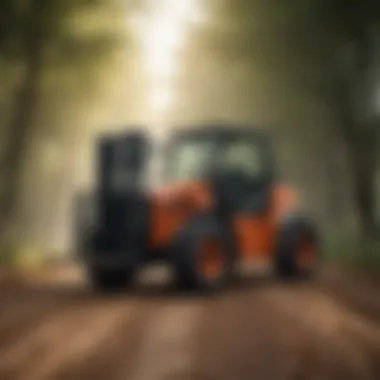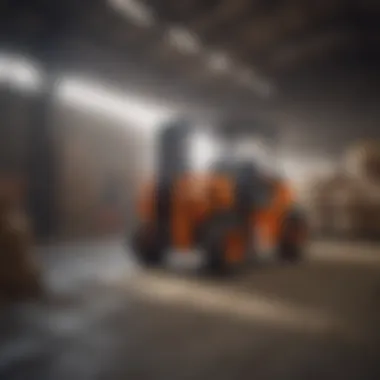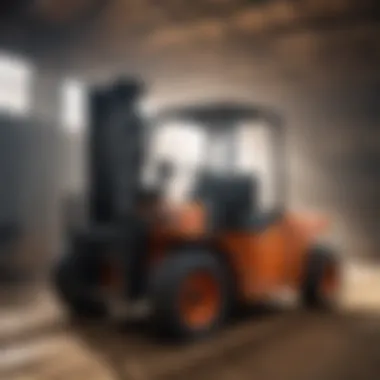Exploring Case Off Road Forklifts: Design and Efficiency


Intro
Off-road forklifts are an essential piece of machinery in many industries, particularly agriculture and construction. These vehicles are designed to operate efficiently in unpaved and rough terrain. This article focuses on the Case off-road forklift models, examining their specifications, performance, and advantages.
As more businesses recognize the value of off-road forklifts, understanding their capabilities becomes increasingly important. These forklifts are not just about lifting and moving heavy loads; they significantly enhance operational efficiency in challenging environments. In the upcoming sections, we will delve into the key aspects that define Case off-road forklifts, from their design to current market trends.
Overview of the Topic
Definition and Importance
Off-road forklifts are specialized vehicles designed to handle the rigorous demands of outdoor operations. Unlike standard forklifts, these machines feature enhanced durability, higher ground clearance, and specialized tires for improved traction on challenging surfaces.
The importance of these forklifts in agriculture cannot be overstated. They are used to transport materials across fields, ensuring seamless workflows. Their capability to operate in harsh conditions allows farmers to perform tasks that traditional forklifts cannot manage, making them a crucial asset in modern farming.
Current Trends
The off-road forklift market is experiencing notable changes driven by technological advancements. Innovations in engine efficiency and safety features are prevalent. Manufacturers, including Case, are focusing on enhancing fuel economy and lowering emissions. This aligns with a broader industry movement towards sustainability.
Another trend is the integration of smart technology in equipment design. Features such as telematics systems offer valuable data on performance, helping operators improve efficiency. Consumers are increasingly prioritizing these high-tech features in their purchasing decisions.
Prologue to Off-Road Forklifts
Off-road forklifts serve a critical role in numerous sectors, particularly in agriculture and heavy industry. Their design allows them to navigate rough terrains where standard forklifts would struggle. This adaptability is essential in managing the diverse conditions found on farms, construction sites, and other challenging environments.
Definition and Purpose
An off-road forklift is engineered specifically to handle tasks on uneven or rugged landscapes. Unlike conventional forklifts, they typically feature enhanced tires, robust frames, and powerful engines that improve their stability and traction. The main purpose of these machines is to facilitate the movement of heavy loads in locations where traditional material handling equipment would be ineffective.
Importance in Agriculture and Industry
In the agricultural sector, off-road forklifts are vital for loading, unloading, and transporting produce and supplies across fields and uneven surfaces. They help in saving time, enhancing efficiency, and ensuring that labor is used more effectively. In industrial applications, these forklifts are critical for managing heavy materials in locations such as job sites or factories where terrain conditions can vary significantly.
The effectiveness of off-road forklifts in tough conditions allows businesses to streamline operations and increase productivity.
Ultimately, understanding the role and capabilities of off-road forklifts is essential for professionals in agriculture and industry, as they contribute significantly to operational efficiency and safety.
Overview of Case Off-Road Forklifts
Understanding the Case off-road forklifts is essential for professionals in agriculture and industries requiring material handling. These machines are designed to operate in challenging terrains where conventional forklifts may struggle. They demonstrate a blend of power, durability, and versatility. This overview highlights the significant aspects, including the history of the brand and the current offerings.
History of Case Forklifts
Case Corporation has a long history in the equipment industry, which dates back to the late 19th century. Founded by Jerome Increase Case in 1842, the company initially focused on steam engines and agricultural equipment.
The transition into forklift technology began in the 1960s when Case expanded its product line to include materials handling equipment. The introduction of the off-road forklift represented a significant advancement. These machines were specifically built to maneuver across uneven land, making them suitable for farms and various industrial sites.
Over the decades, the brand has continued to innovate, aligning its products with the evolving needs of the market and advancements in technology. Notably, Case has become recognized for implementing robust engineering and performance standards.
Current Product Lineup
Today, the Case off-road forklift lineup consists of several models, each designed to meet various demands. These models are characterized by their capability to work in diverse conditions, from muddy fields to rocky terrains.
- Case 570N EP - This model boasts a strong hydraulic system, ideal for lifting heavy loads with efficiency.
- Case 580N - Known for its loader backhoe functionality, this forklift offers excellent versatility for various jobs.
- Case 590N - Advanced technology features enhance its performance, particularly in challenging environments.
The current lineup also emphasizes operator convenience and safety, integrating features such as ergonomic controls and enhanced visibility, which aim to improve overall job safety.


By continually updating its offerings, Case ensures that its forklifts meet the demands of modern agricultural practices and industrial applications, solidifying its position as a leader in this sector.
Design Features of Case Off-Road Forklifts
The design features of Case off-road forklifts play a critical role in their functionality and efficiency. These features not only enhance the performance of the forklifts but also ensure that they meet the specific needs of diverse industries, particularly agriculture. What defines Case forklifts is their robust build, excellent maneuverability, and ergonomic considerations for operators. Understanding these design aspects can help users make informed decisions about which models best suit their requirements.
Robust Construction
Robust construction is a hallmark of Case off-road forklifts. These machines are built to withstand harsh environments often encountered on farms and construction sites. The use of high-strength materials in the chassis and frame provides durability that is essential for heavy-load handling. This level of construction ensures that the forklift can support weighty materials without compromising stability.
In addition to this, Case off-road forklifts feature reinforced components which significantly reduce the risk of breakdowns. This not only prolongs the life of the machine but also minimizes downtime, contributing positively to operational efficiency. Farmers and industrial operators benefit greatly from this robustness as they often work in rough terrain where equipment failure is not an option.
Maneuverability and Stability
Maneuverability is another essential design aspect of Case off-road forklifts. These machines possess a design that promotes superior turning capabilities and control. Tight spaces, often found in agricultural settings, require attributes that allow operators to navigate with ease. Case forklifts achieve this through a short wheelbase and responsive steering, facilitating smooth operation even in confined areas.
Stability is equally vital, especially when lifting loads. Case off-road forklifts are designed with a low center of gravity, which enhances balance and reduces the risk of tipping over during operation. This design feature is important for protecting both the operator and the materials being handled. Operators are assured of safety as they move around different terrains, which can often be uneven or steep.
Ergonomics and Operator Comfort
Consideration for operator comfort is not overlooked in the design of Case off-road forklifts. These machines are equipped with features designed to reduce operator fatigue and enhance productivity. Adjustable seats and intuitive controls ensure that operators can maintain an ergonomic position while working for extended periods.
Moreover, noise-reduction measures are implemented within the cabin to help create a quieter working environment. This is particularly essential in agricultural settings, where continuous use of machinery can lead to long hours on the job. The overall design prioritizes the well-being of the operator, resulting in improved focus and effectiveness while handling materials in the field.
Case off-road forklifts exemplify a blend of robust construction, superior maneuverability, and dedicated ergonomic design that ensures both operator safety and productivity.
Operational Efficiency
Operational efficiency is a critical factor in maximizing the effectiveness of Case off-road forklifts. This concept encapsulates the ability to perform tasks with minimal wasted effort, resources, and time, which ultimately determines the productivity of both the equipment and the workforce. Achieving high operational efficiency is essential for farmers and industrial users who require reliable machinery to handle their specific needs in challenging environments.
Power and Performance Metrics
When evaluating power and performance metrics, Case off-road forklifts stand out with impressive specifications that cater to various job demands. These models often feature powerful engines designed to deliver high torque at low speeds. This characteristic is particularly beneficial when lifting heavy loads in rough terrains, where traditional forklifts may struggle.
Power ratings usually range from mid-50s to over 100 horsepower, depending on the model. This allows operators to complete tasks more efficiently, cutting down on the overall time required to move materials.
Performance metrics also include lift capacity, reach height, and stability. For instance, many Case models offer a lift capacity of over 5,000 pounds, making them suitable for agricultural lifting and transport tasks. Additionally, reach height variations enable operators to access varying stack heights, crucial for warehouse or agricultural applications requiring different loading strategies.
Fuel Efficiency Considerations
Fuel efficiency is another key aspect of operational efficiency for Case off-road forklifts. In an industry where operational costs can be significant, optimizing fuel consumption not only reduces expenses but also lowers environmental impact. Case has made strides in incorporating fuel-efficient engines that comply with current emissions standards.
Several factors contribute to the fuel efficiency of these forklifts, including:
- Engine Technology: Modern engines utilize advanced combustion technology to optimize fuel usage, ensuring that less fuel is needed for the same amount of work.
- Transmission Systems: Some Case models now incorporate hydrostatic drive systems that allow for smoother transitions between speeds, reducing energy loss during operation.
- Weight Distribution: Proper design considers weight distribution, which allows for better balance while lifting, requiring less power and fuel overall.
By focusing on fuel efficiency, operators can expect to see reduced downtime and increased productivity. When forklifts consume less fuel, more work can be performed in a shorter time frame.
Effective management of power and fuel efficiency contributes to a forklift's overall operational efficiency, assisting users in achieving their goals with sustainability in mind.
Applications in Agriculture
In the realm of agriculture, off-road forklifts play a crucial role. These machines contribute significantly to enhancing productivity and efficiency in various farming operations. The adaptability of Case off-road forklifts allows farmers to handle significant challenges, particularly in rough terrain and demanding conditions.
Handling Materials in Rough Terrain
Handling materials effectively in rough terrain is essential for agricultural operations. Case off-road forklifts are designed to navigate challenging landscapes, such as muddy fields and uneven surfaces. Their robust construction and specialized tires prevent slippage and maximize traction. This capability ensures smooth transporting of goods like feed, fertilizers, and farm equipment.


In many scenarios, farmers face the task of moving heavy loads across fields often affected by weather. For example, after rain, traditional forklifts may get stuck, while Case forklifts continue to operate efficiently. By minimizing downtime, farmers can maintain workflow and ensure timely harvesting and planting. The ability to lift and carry large loads easily helps farmers optimize their operations.
Furthermore, the visibility offered by Case models enhances safety when operating in complex environments. Operators can better judge distances and avoid obstacles, reducing the risk of accidents.
Utility in Crop Management
Effective crop management is critical for maximizing yields. Case off-road forklifts are advantageous in this area due to their versatility. They can assist in various tasks, such as transporting harvested crops, moving supplies for planting, and managing inventory in storage facilities.
With these forklifts, farmers can streamline processes related to crop handling. For instance, when crops are harvested, they need to be quickly and safely transported to storage areas. Case forklifts have the capacity to handle bulk loads, thus reducing the need for additional machinery.
Additionally, farmers often need to manage logistics of seeds and fertilizers. Off-road forklifts make it easier to distribute these materials efficiently across the farm. This enables effective crop management by ensuring timely input delivery and distribution.
"The right machinery is essential to optimize farm operations, reducing labor costs and increasing output."
Safety Considerations
Safety is a crucial aspect of operating Case off-road forklifts, impacting both the operators and the overall efficiency of the equipment. These machines are designed for rugged terrains where accidents can occur more frequently. Therefore, understanding safety considerations is essential for anyone involved in their use, especially in agricultural settings.
Proper safety protocols ensure that operators are protected from injuries while also maintaining the integrity of the machinery. The comparison of operational conditions in agriculture and construction highlights the need for comprehensive safety measures within different contexts.
Operator Safety Standards
Establishing solid operator safety standards is fundamental for the effective use of Case off-road forklifts. These standards involve training programs that cover various operational scenarios, ensuring that workers are adequately prepared to handle unexpected situations. The training should include comprehensive knowledge about load limits, steering controls, and emergency protocols.
Key components of operator safety standards include:
- Regular Training Refreshers: Operators should undergo periodic training sessions, reinforcing skills and knowledge.
- Personal Protective Equipment (PPE): It is imperative that operators wear appropriate PPE, including hard hats, safety glasses, and gloves, to mitigate risks of injury.
- Load Awareness: Operators must be trained to assess the load properly. Overloading can lead to tipping or loss of control, especially on uneven surfaces.
- Visibility Protocols: Operators should maintain clear visibility at all times. Utilizing mirrors and ensuring the surrounding area is clear can help in preventing accidents.
Maintaining these standards ensures compliance with local regulations and enhances the working conditions on site.
Maintenance of Safety Features
Maintaining safety features on Case off-road forklifts is an ongoing responsibility that extends beyond initial purchase. Regular assessments and prompt repairs of safety systems—like brakes, lights, and hydraulic systems—are vital for ensuring the machines function correctly.
Consider the following maintenance practices:
- Routine Inspections: Scheduled inspections focus on critical components like lift controls and tires, preventing failures that could lead to accidents.
- Replacement of Worn Parts: Any safety-related component that shows signs of wear must be replaced immediately. This includes tires, belts, and brake components.
- Hydraulic System Checks: Given the crucial role of hydraulics in forklift operation, monitoring for leaks and maintaining pressure is essential for safe operation.
- Documentation of Repairs and Inspections: Keeping accurate records of all maintenance activities can support compliance with safety regulations and improve accountability.
"Investing in safety is investing in productivity and efficiency."
For further details on safety regulations and operator training, resources like Wikipedia and Britannica offer valuable insights.
Maintenance Practices for Case Off-Road Forklifts
Maintenance practices are vital to the longevity and performance of Case off-road forklifts. Regular upkeep ensures that these machines operate optimally, especially in challenging environments often encountered in agricultural and industrial settings. The investment in routine maintenance not only enhances the equipment's life but also improves safety for operators and bystanders, reducing the chances of accidents due to mechanical failures. In summary, good maintenance leads to reliability, efficiency, and safety, making it an essential element for anyone utilizing these forklifts.
Regular Inspection Protocols
Regular inspection protocols serve as the backbone of maintenance practices for Case off-road forklifts. These inspections help to identify potential issues before they escalate into serious problems. Inspections should be conducted daily or after any significant use. Operators should check oil levels, tire conditions, and hydraulic fluid regularly.
It is important to:
- Visually inspect all hydraulic hoses and connections for leaks.
- Assess the frame and body for any signs of damage or rust.
- Test brakes and lights to ensure they are functioning properly.
These simple steps can prevent costly repairs and enhance productivity. Keeping detailed records of inspections also helps track the machine's condition over time, providing essential data for future maintenance or resale.


Repair and Service Guidelines
Repair and service guidelines are critical for ensuring that Case off-road forklifts maintain their performance. When repairs are needed, it is advisable to refer to the manufacturer's manual for specific instructions. Trained personnel should perform any significant repairs, as improper fixes can compromise the machine's safety and efficiency.
Some key points to include in repair and service practices are:
- Timely repairs: Address any repair issues immediately to prevent further damage.
- Genuine Parts: Use Case approved parts to maintain warranties and ensure compatibility.
- Professional Service: Engage certified service technicians who understand the specific requirements of Case off-road forklifts.
A strong maintenance routine, complemented by adherence to repair guidelines, will keep these machines running smoothly.
Regular inspections and prompt repairs can significantly extend the lifespan and efficiency of Case off-road forklifts.
Market Trends and Innovations
The landscape of material handling is ever-evolving, particularly in the realm of off-road forklifts. Understanding market trends and innovations is crucial for farmers and industrial operators alike. These trends not only reflect advancements in technology but also highlight shifting demands and preferences from consumers. In particular, Case off-road forklifts have been at the forefront of this evolution, adapting to meet the distinct requirements of various applications in agriculture and industry.
Technological Advances in Off-Road Forklifts
Recent years have seen considerable technological advances in the construction and capabilities of off-road forklifts. Manufacturers like Case are integrating cutting-edge features to enhance performance, safety, and efficiency.
- Telematics Systems: Advanced telematics allow users to monitor the performance and condition of their forklifts remotely. This data is crucial for optimizing maintenance schedules and improving operational efficiency.
- Enhanced Hydraulic Systems: Modern hydraulics in Case forklifts enable better load handling and increased lift capacities, which translate into improved productivity.
- Electric Drives: The transition to electric-powered units is gaining traction. These models offer lower operational costs and a quieter, more environmentally friendly alternative compared to traditional diesel engines.
- Automated Features: Automation is slowly entering the off-road forklift market, with options like automatic load leveling and operator assistance tools, making for simpler operation.
These advancements not only improve efficiency but also help in addressing challenges associated with labor shortages in agriculture and manufacturing sectors. Each innovation stems from an ongoing commitment to enhance the usability and performance of off-road forklift equipment.
Sustainability Initiatives in Design
Sustainability has become an essential component of modern forklift design. Case has been a frontrunner in implementing sustainability initiatives that address environmental concerns while maintaining efficiency.
"Sustainability in forklift design is not just about reducing emissions, it is about creating a responsible approach to manufacturing and operational practices."
- Eco-Friendly Materials: Many Case off-road forklifts are now constructed with recyclable materials. This not only benefits the environment but also appeals to consumers who are conscious about their carbon footprint.
- Energy Efficient Designs: Innovations such as optimized engine performance and lightweight components help reduce fuel consumption. This is an essential factor for farmers who operate equipment for long hours in challenging terrains.
- Lifecycle Management: Manufacturers are now considering the entire lifecycle of products, ensuring that end-of-life recycling options are available. This holistic approach is vital for minimizing landfill waste.
- Carbon Footprint Reduction: Co2 emissions are continuously monitored and strategies placed to reduce emissions during the production process.
Comparative Analysis with Competitors
In the competitive landscape of off-road forklifts, understanding how Case models stack up against their competitors is essential. This section provides insight into performance metrics and cost considerations that impact purchasing decisions. By examining these factors, potential buyers can make informed decisions that align with their specific operational needs.
Evaluating Performance Metrics
Performance metrics provide valuable data on how well an off-road forklift operates under various conditions. For Case off-road forklifts, several key specifications come into play:
- Lifting Capacity: Case models generally offer robust lifting capabilities, allowing them to handle heavy loads effectively.
- Engine Power: The horsepower of a forklift affects its ability to navigate tough terrain and heavy lifting tasks.
- Maneuverability: The turning radius and wheelbase can determine how well the forklift can operate in confined spaces or rough landscapes.
When comparing to competitors like Caterpillar, Bobcat, and Hyster, each brand will have unique strengths. Competitors may prevail in some aspects but could lag in others such as fuel efficiency or operator comfort. This analysis ensures that buyers can weigh these metrics against their specific needs, ensuring a suitable choice for their operational environment.
Cost of Ownership Considerations
The cost of ownership is a critical aspect that includes initial purchase price, maintenance costs, and resale value. For Case off-road forklifts, consider the following:
- Initial Investment: Case forklifts often present competitive pricing in the market. It’s important for buyers to compare this against specifications and performance advantages.
- Maintenance Expenses: Understanding what routine servicing or parts replacement may be required is crucial. Case models typically offer straightforward maintenance due to their design.
- Resale Value: An often-overlooked factor is the future resale value of the forklift. Case has a reputation for enduring quality, which can positively impact resale value compared to brands with lower recognition.
By carefully analyzing these factors, companies can not only assess the initial impact on their budgets but also plan for future costs associated with operation and upkeep. Evaluating performance metrics in conjunction with these financial aspects allows businesses to gain a comprehensive view of what Case off-road forklifts offer in contrast to the competition.
Epilogue
The conclusion of this article encapsulates the critical insights gleaned from the comprehensive analysis of Case Off-Road Forklifts. This section highlights the significant contributions these machines make to agriculture and industrial sectors. Specifically, the performance, design, and safety features of Case forklifts stand out as essential elements that facilitate efficient operations in challenging environments.
Summary of Findings
Throughout the article, we have examined several key points regarding Case Off-Road Forklifts. Their robust construction ensures durability, making them suitable for rough terrains. Key features include efficient power metrics and excellent maneuverability, which contribute to reduced operational downtime. Additionally, we observed the importance of adhering to operator safety standards and the value of regular maintenance practices. Investing in these forklifts represents not only a financial commitment but also an essential step toward enhancing work productivity and safety.
Future Outlook for Off-Road Forklifts
Looking ahead, the future of off-road forklifts appears promising due to ongoing innovations in technology and design. As the industry pivots toward sustainability, manufacturers are increasingly focusing on eco-friendly practices and alternative energy sources. Enhancements in automation and smart technology integration are likely to reshape their operation. For professionals in agriculture, these changes can lead to more efficient machinery, thus reducing labor costs and environmental impact. Overall, the importance of staying informed about these trends is paramount for anyone considering or currently utilizing Case Off-Road Forklifts.



